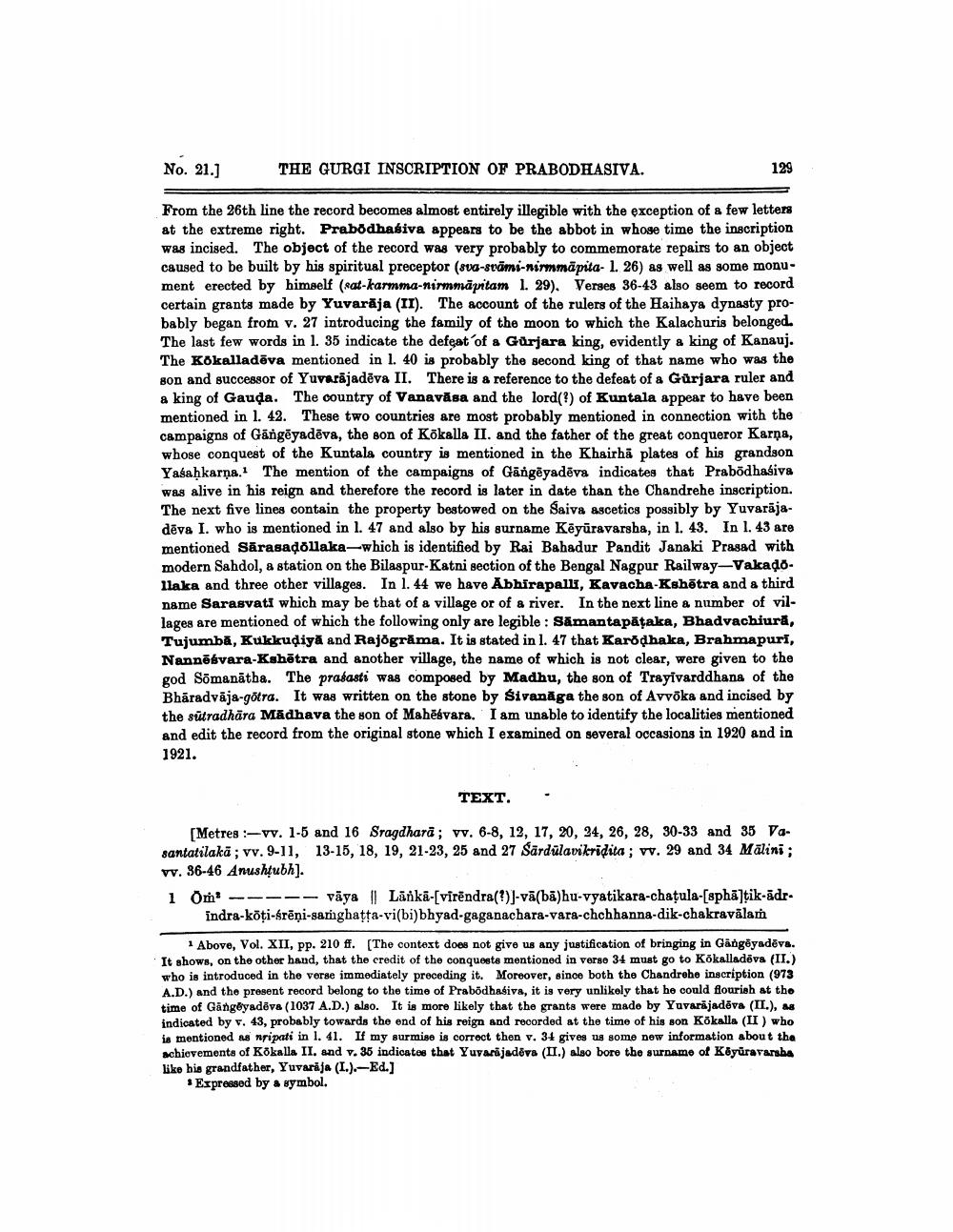________________
No. 21.]
THE GURGI INSCRIPTION OF PRABODHASIVA.
129
From the 26th line the record becomes almost entirely illegible with the exception of a few letters at the extreme right. Prabodhaśiva appears to be the abbot in whose time the inscription was incised. The object of the record was very probably to commemorate repairs to an object caused to be built by his spiritual preceptor (sva-srāmi-nirmmäpita- 1. 26) as well as some monument erected by himself (sat-karmma-nirmmāpitam l. 29). Verses 36-43 also seem to record certain grants made by Yuvarāja (II). The account of the rulers of the Haihaya dynasty probably began from v. 27 introducing the family of the moon to which the Kalachuris belonged. The last few words in l. 35 indicate the defeat of a Gurjara king, evidently a king of Kanauj. The Kokalladēva mentioned in l. 40 is probably the second king of that name who was the son and successor of Yuvarājadēva II. There is a reference to the defeat of a Gurjara ruler and a king of Gauda. The country of Vanavāsa and the lord(?) of Kuntala appear to have been mentioned in l. 42. These two countries are most probably mentioned in connection with the campaigns of Găngěyadēva, the son of Kökalla II. and the father of the great conqueror Karņa, whose conquest of the Kuntala country is mentioned in the Khairhā plates of his grandson Yasahkarņa. The mention of the campaigns of GängĒyadēva indicates that Prabodhasiva was alive in his reign and therefore the record is later in date than the Chandrehe inscription. The next five lines contain the property bestowed on the Saiva ascetics possibly by Yuvarājadēva I. who is mentioned in l. 47 and also by his surname Kēgūravarsha, in l. 43. In 1. 43 are mentioned SĀrasadollaka-which is identified by Rai Bahadur Pandit Janaki Prasad with modern Sahdol, a station on the Bilaspur-Katni section of the Bengal Nagpur Railway-Vakado. Ilaka and three other villages. In 1. 44 we have Abhirapalli, Kavacha-Kshētra and a third name Sarasvati which may be that of a village or of a river. In the next line a number of villages are mentioned of which the following only are legible: Sāmantapāțaka, Bhadvachiura, Tujumbā, Kukkudiya and Rajögrāma. It is stated in l. 47 that Karðdhaka, Brahmapuri, Nannēsvara-Kahātra and another village, the name of which is not clear, were given to the god Sõmanātha. The prasasti was composed by Madhu, the son of Trayivarddhans of the Bhāradvāja-gotra. It was written on the stone by Sivanāga the son of Avvoka and incised by the sutradhāra Madhava the son of Mahēsvara. I am unable to identify the localities mentioned and edit the record from the original stone which I examined on several occasions in 1920 and in
1921.
TEXT.
Metres :- vv. 1-5 and 16 Sragdhara; vv. 6-8, 12, 17, 20, 24, 26, 28, 30-33 and 35 Vasantatilakā; vv. 9-11, 13-15, 18, 19, 21-23, 25 and 27 Sārdülavikridita ; v. 29 and 34 Mālini; vv. 36-46 Anushțubh]. 1 Om ----- vāya || Länkā-[virēndra(!))-vā(bā)hu-vyatikara-chatula-[sphā]tik-adr.
indra-köți-érēņi-samghatta-vi(bi)bhyad-gaganachara-vara-chchhanna-dik-chakravālam
Above, Vol. XII, pp. 210 ff. The context does not give us any justification of bringing in Gängēgadēve. It shows, on the other hand, that the credit of the conqueste mentioned in verso 34 must go to Kokalladiva (II.) who is introduced in the verse immediately preceding it. Moreover, since both the Chandrebe inscription (973 A.D.) and the present record belong to the time of Prabodhagiva, it is very unlikely that he could flourish at the time of Gang@yadēva (1037 A.D.) also. It is more likely that the grants were made by Yuvarājadēva (II.), as indicated by . 43, probably towards the end of his reign and recorded at the time of his son Kökalla (II) who is mentioned as npipati in l. 41. If my surmise is correct then v. 34 gives us some new information about the achievements of Kökalla II. and v. 35 indicates that Yuvarājadēvs (II.) also bore the surname of Kéyüravarsha like his grandfather, Yuvarija (L.).-Ed.]
· Expressed by a symbol.




